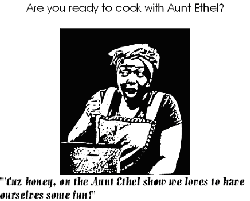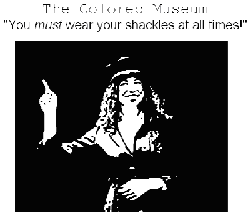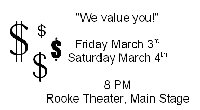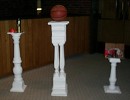The Colored Museum
Dramaturgical Production Notebook
Production History
Textual Lineage
Script Preparation
Playwright Chronology
Contextual Chronology
The dramaturgical promotion of this play consists of the program, the lobby display, and the table tents.
Table Tents
At Mount Holyoke College, table tents are an integral part of advertising. The following graphics were the official table tents for The Colored Museum. Both of the tents also listed time, date, and location of the show.
To view larger (more detailed) images, please click to open.
Program
The program is important for any show at Mount Holyoke because it allows the audience to see who has worked on the production; furthermore, it gives the audience something to read before the show starts. The program was also meant to add some flavor to the show, as it contains directors notes. The full formatted program can be viewed in PDF format below, but the front cover is also presented.
Page One: Cover
The Colored Museum
by George C. Wolfe
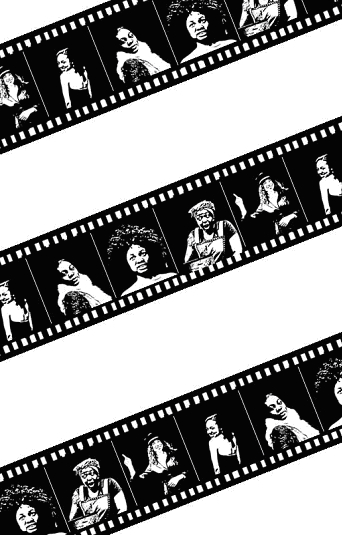
In Celebration of Black History Month
Caution: A strobe light will be used during this performance.
The lobby display's theme was to represent somewhat of a continuation of a museum. To achieve this, various "exhibits" were designed for people to view prior to seeing the show. The directors also wanted a bit of randomness to the appearance, or the feeling of having too many things going on at one time. The items in the lobby, however, still had to be linked to the show. All the images here can be enlarged by clicking.
 Television: Too Much is going on!
Television: Too Much is going on!
The first part of the lobby display aimed to make the waiting audience feel as if there was too much going on at once. Three televisions were stacked in a corner by the entrance. The smallest grey monitor was blank; no additional DVD player could be found to have it play. However, had it worked, it would have been playing the movie Crash. The larger grey television played the movie Sister Act II while the largest black television played Dave Chappelle, a black comedian, doing stand up comedy.
Sister Act II and Dave Chappelle were chosen to contrast two of the main media images of black comedy; Chappelle himself is very famous for his show. Crash was also to provide contrast and give a more serious theme. However, without Crash the set up worked very nicely because both the movies were related to black comedy, which is part of The Colored Museum.
 Bondage Symbolism
Bondage Symbolism
The next part of the lobby display was this mannequin. The shirt reads "Africa" with prints of the continent over it. The skirt is modeled after certain African clothing. Around the mannequin's neck is a collar and chain, which represent bondage. This was a more serious entry in the lobby display, which helped to contrast the two comedies playing across the lobby from it.

 Statistics
Statistics
The two black boards in the lobby (one located near the televisions, one located across the room) were filled with different statistics of black Americans. These were meant to be supplements (and updates) for what the actual play did not cover.
The following web pages were used as sources for various statistics. These collections were generally from mixed backgrounds.
- National Black United Fund: Philanthropy
- National Black United Fund: Education, Employment, and Economics
- National Black United Fund: Digital Divide
- National Black United Fund: Health Disparities
- National Black United Fund: The Justice System
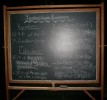 Black Education
Black Education
To highlight certain statistics, some were pulled out and put on this board. These specifically related to black education and population. The label "black American" or "black" was left out intentionally to force people to realize that, generally, if a race is not mentioned, they will assume it is aracial and/or white. Furthermore, it also points out the disparity between the "average statistics" known to people (eg--that 60% of high school graduates go to college) and the statistics for black Americans.
- Population
- 13.4% of the United States
- 39.2 Million People
- Education
- 85% of high school students graduate
- ~50% of them go on to college
- 1 out of 5 attend to a historically black college

 Religion
Religion
Another area of concern is the fact that black Americans are often associated with Christianity. Issues relating to religion and money are also of interest. On this kneeler is a book of songs for religious purposes. The following statistics were above it:
- More than half (52%) of black households make charitable donations. -- White House Council of Economic Advisors, 2000
- Blacks are more likely to give to religious organizations than to formal philanthropic groups: about 60% of black giving is to churches. -- White House Council of Economic Advisors, 2000
- Black churches and mutual aid associations were the first Black philanthropic organizations. -- Twenty-First Century Foundation, 2001
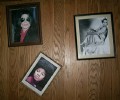 Images of Black Americans
Images of Black Americans
Because of certain references in the play, Michael Jackson's photographs were used for this display. In "Symbiosis," the character mentions Michael having a black nose, so two images of him were taking (one when he was younger and a current one). Josaphine Baker was also framed and on the wall because she is mentioned in "Lala's Opening".
 Adjacent to the photo display is the display to the right. The wig head has a black-haired wig that represents some of the comments on hair in the play. The photograph next to it is of W. E. B. DuBois, which was used to contrast all the direct relation to the play.
Adjacent to the photo display is the display to the right. The wig head has a black-haired wig that represents some of the comments on hair in the play. The photograph next to it is of W. E. B. DuBois, which was used to contrast all the direct relation to the play.
The Museum Mirror
One of the goals was to make the lobby seem like an extension of the museum. To achieve this partially, three "columns" were used to create the feeling of a museum or other kind of display. Like the Olympics, the columns were not level; they possessed "ranks" similar to the Olympics, too.
 In third place, black musicians' CDs were ranked. The items were ranked by their relation to the show and their status in popular American culture. Black musicians like Louis Armstrong were very popular in American culture. "Lala's Opening" presents a stereotype of a black musician. Furthermore, one of the most popular features of black culture is music.
In third place, black musicians' CDs were ranked. The items were ranked by their relation to the show and their status in popular American culture. Black musicians like Louis Armstrong were very popular in American culture. "Lala's Opening" presents a stereotype of a black musician. Furthermore, one of the most popular features of black culture is music.
 Black hair care products come in at second place. "Hairpiece" is dedicated exclusively to the stereotypes associated with black hair, especially women's hair. Other references to hair are throughout the play, too. The reason that this comes in second (rather than third) is that the play highlights this as an issue, which may have not been known by the larger population.
Black hair care products come in at second place. "Hairpiece" is dedicated exclusively to the stereotypes associated with black hair, especially women's hair. Other references to hair are throughout the play, too. The reason that this comes in second (rather than third) is that the play highlights this as an issue, which may have not been known by the larger population.
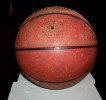 Finally, the basketball is ranked as first place. This is because Miss Pat tells the slaves that "with this little item here, you'll become millionaires!" Another popular part of black culture is athleticism, which is address to a small degree in the play. The play also addresses the fact that this is one of the methods for black Americans to gain financial success.
Finally, the basketball is ranked as first place. This is because Miss Pat tells the slaves that "with this little item here, you'll become millionaires!" Another popular part of black culture is athleticism, which is address to a small degree in the play. The play also addresses the fact that this is one of the methods for black Americans to gain financial success.
Information last updated May 14, 2006. Page last updated 3 October 2009.
